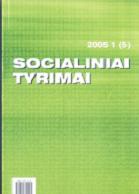The Relation Between Unit Labour Cost and Export Competitiveness in Estonian Manufacturing Industry
The Relation Between Unit Labour Cost and Export Competitiveness in Estonian Manufacturing Industry
Author(s): Dorel TammSubject(s): Social Sciences
Published by: VšĮ Šiaulių universiteto leidykla
Keywords: Unit labour cost; export competitiveness; manufacturing industry;
Summary/Abstract: The globalisation process along with removal of trade barriers is increasing competition among countries. As a result more attention is turned to the sources of export competitiveness and to their better use. For that reason the research in the area of com-petitiveness is intensified. The research of export competitiveness is more actual in those countries where import exceeds export. Since regaining its independence Estonia’s imports have annually ex-ceeded its exports, signalling that more attention must be paid to enhancing of exports relative to imports. One way of doing that is the maximal exploitation of the existing export advantage. To specify the sources of export advantages it is necessary to explore possi-ble sources more precisely. Up to now Estonia’s export competitiveness originates primarily from low labour costs that have shaped export structure and attracted foreign direct investments. Being a member state of the European Union, labours costs are expected to grow faster in Estonia. Estonia could lose its status of being a good location for labour intensive production. This could bring along the reallocation of enterprises to countries where labour costs are still very low. Given the up-ward pressure on labour costs, maintaining competi-tiveness require an increase in productivity or gaining an international advantage through innovation. Inno-vation could increase the volume of production with-out increasing production inputs. It could also lead to the elaboration of new or modified product, which has higher value-added. The aim of this article is to examine whether changes in unit labour costs brought along changes in export competitiveness of the Estonian manufactur-ing industry. The article is divided into two parts. The first part of the article is theoretical and explains the concept of export competitiveness. Also different indicators of export competitiveness are compared based on the role of labour costs. The second part of the article includes analysis of changes in the Esto-nian manufacturing industry’s export competitiveness on the basis of unit labour costs.
Journal: Socialiniai tyrimai
- Issue Year: 2005
- Issue No: 5
- Page Range: 136-142
- Page Count: 7
- Language: English

